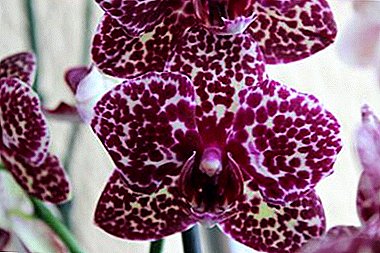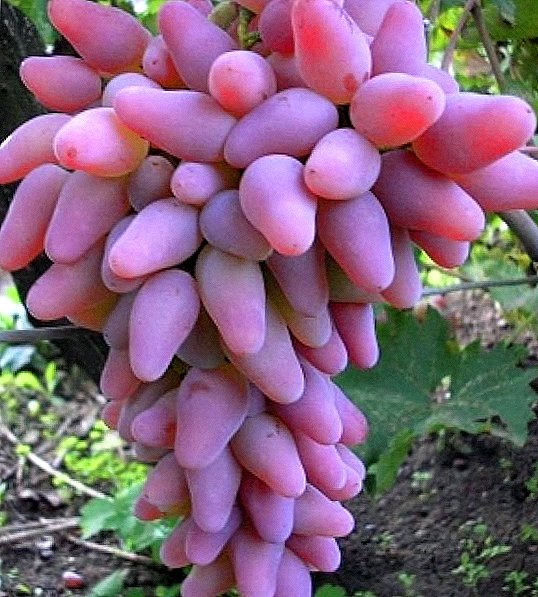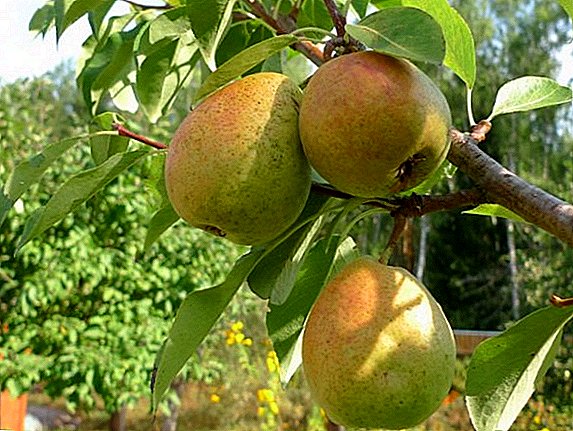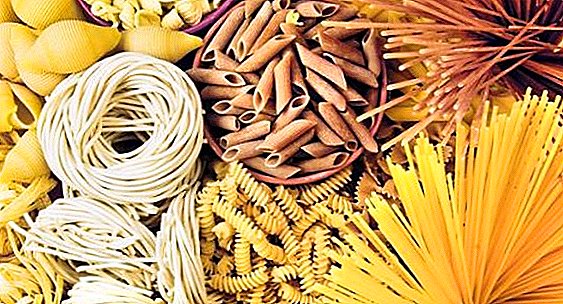
To date, the orchid displaces the rose from the pedestal of the Queen of Flowers. This trembling flower is considered a symbol of tenderness, therefore it is often presented as a gift to lovers of any gender.
The most popular type is phalaenopsis. At the moment, varieties of this variety, there are about seven dozen.
Among them is a rare original flower called Wild Cat. That's about it and will be discussed in the article.
Detailed description of the variety and photos
 Wild Cat - is an orchid, which is characterized by compacted wax petals. In the room where the cat is located, there is a light, subtle scent. Flowers of white (less often - yellow) shade with dense splashes of cherry shade. Often there are so many such blotches that from afar the petals seem completely dark red.
Wild Cat - is an orchid, which is characterized by compacted wax petals. In the room where the cat is located, there is a light, subtle scent. Flowers of white (less often - yellow) shade with dense splashes of cherry shade. Often there are so many such blotches that from afar the petals seem completely dark red.
The buds bloom at this phalaenopsis twice a year. Flower arrows reach a height of more than half a meter.
The size of the flowers ranges from 10-12 centimeters. Due to the high content of wax in the petals, they seem to sparkle in the sun.
The leaf plates are fleshy, wide, grow to a length of 30 centimeters. Usually in an adult plant there are 4-6 leaves. Roots, like all other orchids, take part in photosynthesis, and in the natural environment they also serve as attachment to trees.
History of
There is no beautiful story of breeding the Wild Cat. Just a few years ago, breeders crossed existing orchids, and it turned out a spotty miracle.
The name "Wild Cat" Orchid received due to its appearance - All petals have a spotty coloring, which makes them related to cheetahs.
Reference! In some sources you can find the name White Cat. These are two equivalent names of one phalaenopsis.
What is the difference from other types of orchids?
Finding differences between the “cat” and other phalaenopsis in the resting stage is very difficult, almost impossible. During flowering, such an orchid is easily distinguished from others due to its spotty color.
In order not to fall for unscrupulous sellers, it is better to acquire a plant with at least one full-blown bud. In addition to the fact that there are no differences in appearance, there is no particular difference in the care.
Subsort
There are no names for the subspecies of this orchid. Flower growers simply distinguish them by color. There are white and yellow petals. These petals can be covered with spots of different colors: from pale pink to deep lilac.
Bloom
When and how?
Wild Cat can bloom up to 100 days without interruption. However, when the rest period comes, it does not last very long. Phalaenopsis is only just a month to recuperate. The opening of the bud can occur at any time of the year (this applies to home-grown).
Buds must be at least 7-8 centimeters, the very bloom should last at least two months. If these conditions are not met, then this is a serious reason to be alerted.
Care before and after flowering - features
 Before flowering, the plant needs to create the conditions familiar to phalaenopsis. This will be described in detail below.
Before flowering, the plant needs to create the conditions familiar to phalaenopsis. This will be described in detail below.
But after the last bud fell, you need to carry out several manipulations. To get started is to cut the flower arrow.
But you can do it only when it dries completely. Sometimes it happens that the flower is partially drying. In this case, you need to cut only to the place to which the arrow has dried.
Important! Do not forget to handle cutting sites with crushed coal or cinnamon.
After flowering, an excellent time for orchid transplantation. Just in this period, you can change the pot and the soil. Also in the first weeks after the end of flowering, you can reduce watering slightly and reduce the level of air temperature.
What if there are no buds?
First, you need to check whether all the conditions of the maintenance of orchids. If all factors are provided, and bloom still does not occur, it is necessary to arrange a stressful situation. The easiest way to do this is to ensure the difference in daily temperatures. No need to push the buds to reach adult orchids. This should happen not earlier than two years, and even better - after three.
It often happens that phalaenopsis blooms at an early age, but this does not lead to anything good. Since flowering requires a lot of strength, which the young flower does not yet have. Therefore, usually after early flowering Wild Cat weakens.
Step-by-step care instructions
Choosing a place
It should be a well-lit place. But at the same time there should not be scorching rays. therefore it is better to give preference to the southeast and northeast sides for flower placement.
 If this is not possible, you can put a pot with a pot and on the south side, and on the north side.
If this is not possible, you can put a pot with a pot and on the south side, and on the north side.
But then in the first case, in hot hours, the flower will need to be tinted, and in the second case, on the contrary - very often it will be necessary to use additional lighting.
Do not forget about airing. This should be done regularly, but do not allow the formation of drafts.
Soil preparation and pot
The substrate is best to buy ready-made, intended for the Orchid family. If the florist wants to prepare a soil mixture independently, then for this you need to take in equal frequent bark of pine, sphagnum moss and peat.
Reference! Well before using the bark pour boiling water, pre-grinding.
In any case, we should not forget about the drainage layer. This will guarantee good air circulation. The pot must be transparent. This will allow you to monitor the condition of the roots and soil. In addition, only in such a capacity can the root system perform its function - photosynthesis.
The second condition for choosing a pot should be its smoothness. Otherwise, the roots will grow into the walls of the container, which will lead to their death.
Temperature
In the summer, you need to adhere to the mark of 25-30 degrees above zero.In winter, this bar can be reduced to 20 degrees Celsius. Do not forget about the differences in daily temperature, but do not get carried away - the difference should not be more than five degrees.
Air humidity
Speaking in numbers, it should be in the range of 50-70%. At higher or lower rates, the plant may die from rotting or drought.
Lighting
 It has already been said that any phalaenopsis needs a lot of light. But this light must be diffused.
It has already been said that any phalaenopsis needs a lot of light. But this light must be diffused.
Per day it is necessary to provide at least ten hours of coverage for the Wild Cat, and more is possible.
In winter, it is unlikely that this can be done naturally, so you have to resort to using artificial lighting. This is usually not a problem.
Watering
It is necessary to moisturize the soil, focusing on the condition of the soil. As soon as she keeps a day or two dry, you can water the orchid again. You can immerse the pot for 10-15 minutes in water, or you can water the flower under the shower.
Reference! The amount of light and water produced should be directly proportional.
Top dressing
Wild Cat requires fertilizer only in the period of growth and development. As soon as flowering begins, fertilizing should be limited. Choose better ready store complexes.
It is necessary to strictly follow the instructions for use. This also applies to the dosage and frequency of use.
Transfer
Change the pot and soil need every two years. After getting the plant from the ground, you need to carefully inspect the roots and remove rotten and infected, if any. Do not forget to handle the cut sites. The first few days after transplantation and procedures for removing roots do not need to water phalaenopsis. At this time, you need to give the flower to tighten the wounds.
From the video below you will find out whether it is worth replanting a wild cat and how to do it:
Breeding
Experts call several methods of breeding the Wild Cat.
- Children. This is the easiest way. If shoots appeared on the flower arrow, you need to wait until they take root and grow at least two leaves, and only after that cut them off and transplant them into a separate container.
- Peduncle division. As soon as the buds have fallen, and the flowerbird has not yet had time to dry, you can cut it and divide it into several parts so that at each site there is at least one sleeping kidney. You can grow these particles in a greenhouse with moss at a temperature of 25-27 heat.
- Division of the roots. During transplantation, you can divide the rhizomes into a couple of parts and plant each in a separate pot. If the roots were well developed, one and the second part will grow. However, the first flowering can be seen only after a couple of years.
Diseases and pests
The main ailments characteristic of this variety are fusarium and gray rot. You can treat them with any intended drug.
You should also beware of spider mites and thrips, for the destruction of which insecticides are used. In 99% of cases, all diseases and pests are due to improper care..
Prevention of various problems
In order not to have problems with growing orchids, you need to strictly adhere to all care recommendations. Do everything on time and competently. Also, growers strongly recommend not to experiment with the rules of care, as it usually does not lead to anything good.












